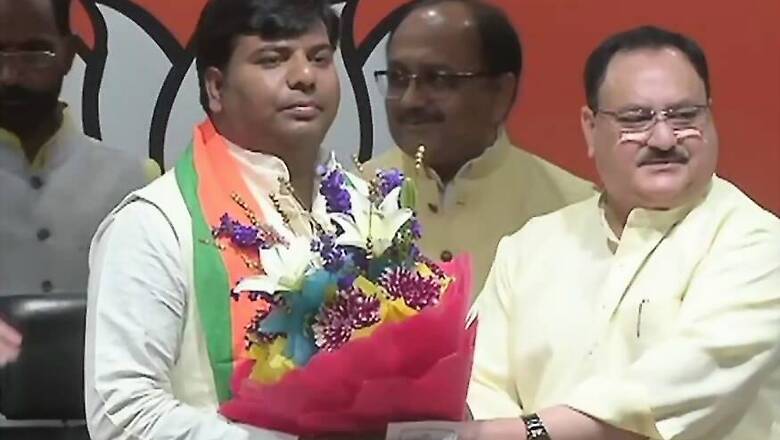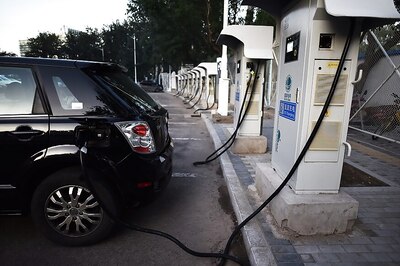
views
New Delhi: There are party tickets and political dinners being offered to Nishad leaders – the members of boatmen community. If there is a Nishad candidate in SP, the BJP is not staying behind in roping them in to garner the boatmen community’s votes. the mainstream parties are waking up to the assertive Nishad caste ...
Ahead of the Lok Sabha elections in 2019, the community is emerging as a new political force to reckon with, especially in the Poorvanchal region - East Uttar Pradesh and bordering areas of West Bihar. If in Bihar, Mukesh Sahni, more popularly known as the ‘Son of Mallah’, has been at the forefront of Nishad politics with his party - Vikasheel Insaan Party (VIP), in Uttar Pradesh there is ‘NISHAD’ party playing a prominent role. It was cleverly named to stand for ‘Nirbal Indian Shoshit Hamara Aam Dal’.
The Nishad leaders are asserting themselves like never before – joining or abandoning a party for realising their political aspirations. In important political developments Praveen Kumar Nishad, who wrested the seat from BJP in a by-election from Gorakhpur on SP ticket has now joined the BJP. The Nishad Party joined the National Democratic Alliance. Praveen Kumar Nishad fighting from the Sant Kabir Nagar on a BJP ticket. Interestingly, Ram Bhuwal Nishad who was earlier with the BJP (2017) has got ticket from SP to fight for Gorakhpur.
The question looming large in Bihar, and will get an answer only on May 23 is “Can VIP help the mahagathbandhan in tapping the Nishad votes?” VIP joined the Bihar grand alliance as it found the Prime Minister Narendra Modi not listening to their demands of reservations. Reservation has been one of central planks of ‘Nishad’ politics. The party is contesting on three crucial Lok Sabha seats and it is said that the VIP’s support base has influence in 10 seats that can help the grand alliance.
The Nishad community comprises 22 sub-castes. Sahni, Punaut, Jethaut, Kaul, Tiyar, Chabh, Bind and Gangait are some of the sub-castes which are collectively a potent political force. There are densely populated villages on the banks of river Ganga and Narayani in Bihar and on the banks of Ganga, Ghaghara, Rapti, Gandak and Yamuna rivers in UP, which are densely populated by Nishads.
Of assertions and aspirations …
In both states, the population of Nishads is believed to be between 14 to 17 percent, around 14 % in Bihar and around 17% in UP. Their political behavior hasn’t been the same in Bihar and UP. After years of living in political insignificance they are now organizing themselves. It is known that Nishad and its sub-castes were not always a united political force and were rife with caste discrimination that extended within the Nishad sub-castes.
Before turning into a constituency itself, the Nishad electorate had showed preference for candidates from their community, be they from BJP, RJD, JDU, SP, BSP or Congress. They had some tall leaders as well to organise them. In Bihar Captain Jaynarayan Nishad, and in UP Phoolan Devi and Vishambhar Nishad are considered such tall leaders of the community who greatly mobilised Nishads across the two states.
News18.com had earlier reported like Jats, Jatavs, Yadavs and Kurmi-Patels, Nishads (of which fishermen are a big sub-community) are finding their own voice and representation in parties made by them, for them. “Interestingly Nishad politics, by and large, is poised against NDA in the upcoming Lok Sabha polls,” it was observed.
This party has been carrying out state wide agitations demanding reservations.
Voicing the ambitions of his community, Mukesh Sahni, or the ‘Son of Mallah’, said “If communities with 3% population can have a CM why can’t communities with 14% have one also”. Lending ambition to their politics, the ‘Jai Nishad Raj’ is an assertion of the Nishad identity and a symbol of the growing political power of Nishads.
Sahni has received a lot of attention by national and regional parties though his mettle on ground remains untested. In a few months’ time he will face his first big test and find out for himself, whether his huge popularity on social media translates to votes on ground.



















Comments
0 comment